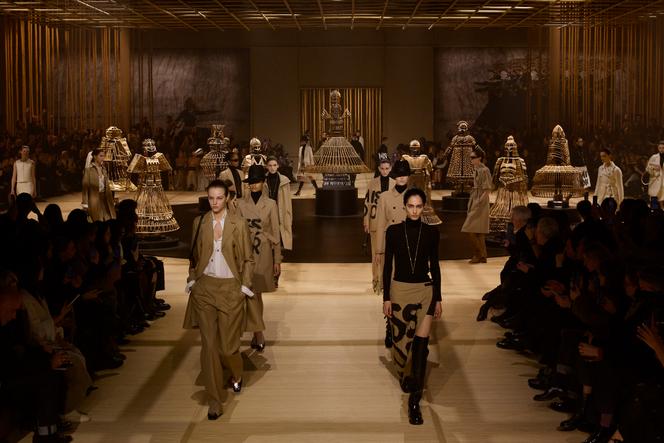


Slowly but surely, Paris Fashion Week continues to swell. For this Fall-Winter 2024-25 season, which runs from February 26 to March 5, the official program has 109 events planned: 71 fashion shows and 38 presentations. This is two more than for Spring-Summer 2024, which was already exceptionally busy. These figures do not reflect the most significant inflation, which is in the unofficial calendar. All kinds of fashion players come to take advantage of the presence of guests from the four corners of the globe in Paris.
Among them are robust foreign delegations from Ukraine, Serbia, Saudi Arabia, Indonesia and North Korea. American department store Neiman Marcus will be handing out its awards to Maria Grazia Chiuri (Dior), Daniel Roseberry (Schiaparelli) and Simon Porte Jacquemus (Jacquemus) at a ceremony at the Ritz on Saturday, March 3. The day before, Jacquemus will receive the Chevalier de l'Ordre des Arts et des Lettres medal from Anna Wintour, editor-in-chief of American Vogue. Between these various ceremonies, brands without shows in Paris will be careful to throw a cocktail party or dinner as a reminder of their existence; those that do have shows will celebrate the event with a party.
In this profusion, the major brands remain true to their habits. On the second day of fashion week, the runways were set for Dior (LVMH) and Saint Laurent (Kering), two flagship houses of competing groups, which, this season, have the commonality of having sought inspiration from the same era: one from 1967, the other from 1966, with radically different results.
Chiuri turned to her predecessor at Dior, Marc Bohan, who, despite his longevity in the position (from 1961 to 1989), tends to be overshadowed in the house's history by more charismatic peers, such as John Galliano, Raf Simons, or, of course, Christian Dior. "He's been underestimated, but his archives are fascinating; you could wear his clothes today," said Chiuri. As proof of his modernity, she mentioned Bohan's initiative to launch a ready-to-wear line, Miss Dior, in 1967, in a house then devoted to haute couture. "Just before the 1968 revolution, he felt the need to produce simpler-to-wear shapes to dialogue with a new generation of women."
Miss Dior is the starting point for Chiuri's collection, where the clean lines of the 1960s (graphic dresses, short skirts, ankle boots) begin to dilute into the hippie atmosphere of the following decade (wide pants, geometric patterns, low-cut sweaters). Neutral colors – beige, black, ivory, anthracite – and meticulous details (gold buttons, grosgrain ribbons, patent leather shoes) give the ensemble an elegant allure, inspired by that of Italian designer and decorator Gabriella Crespi, who at the time epitomized the independent career woman. The only deviation from sleek chic is the "Miss Dior" logo, designed by Alexandre Sache in 1970 and gleaned from the archives, which can be found everywhere, from trench coats to split skirts to bags. "It was Marc Bohan who had the idea of putting a logo on accessories to distinguish them," said Chiuri, who offers a pleasing, wearable and commercial collection, in line with her work at Dior since 2016.
Anthony Vaccarello has other ambitions for Saint Laurent. For the past three years, he has been streamlining his shows. First, accessories disappeared from the catwalk: poof! No more bags, even though leather goods represent a financial windfall for luxury brands. Then the clothes became more radical: an all-vinyl collection, another made of oversized jackets and this one, made almost entirely of pantyhose material. The result is a complete collection of draped dresses, pencil skirts and tan blouses, which all share the quality of being totally transparent. The effect is striking – especially when staged in an immense circular space draped with damask velvet curtains, reminiscent of Avenue Marceau's historic salons – but it's unlikely to get much coverage on social media, which does not allow nudity.
"We could have developed very fine stockinette, but the result was never as beautiful, never as subtle as with the fabric from the pantyhose," explained Vaccarello. "I like the idea of using a fabric that isn't noble and treating it in a couture way: Making a draped top required four days at the atelier." The pantyhose fabric also has the particularity of being very fragile: Most of the pieces are damaged, frayed by the simple fact of being worn. "These are ephemeral garments that make up an unreal collection. There are already so many brands, so many proposals that look the same. I wanted to explore new territories, to fantasize around the name 'Saint Laurent,'" he added.
The founder's name evokes the spirit of controversy. It was he who, in 1966, was the first fashion designer to propose, within a bourgeois wardrobe, a transparent blouse that revealed the breasts. At the time, this garment, which showed what it was supposed to hide, caused a large stir and produced a symbolic revolution in women's clothing. For all that, it didn't spread to the streets, but that's what we remember about Yves Saint-Laurent. Vaccarello seems more interested in the idea of making his mark on fashion history than in selling truckloads of clothes. The idea is noble, the execution perfect; it remains to be seen how Kering, whose sales are down 4% in 2023, can make the equation economically viable.
Translation of an original article published in French on lemonde.fr; the publisher may only be liable for the French version.
